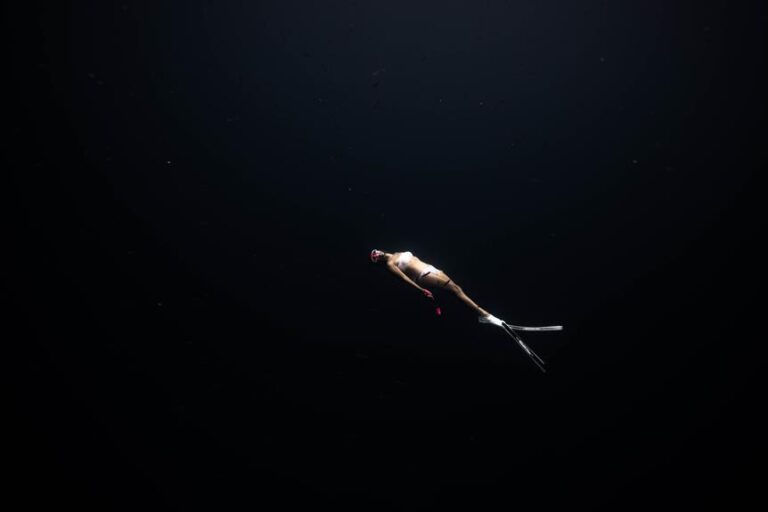Are you ready to dive into the mesmerizing world of night diving?
Prepare to be enchanted as you immerse yourself in the depths of the ocean, surrounded by a captivating array of marine life that comes alive under the cloak of darkness.
Night dives offer a whole new perspective on familiar dive sites, revealing a realm of beauty, color, and mystery.
Get ready to witness the vibrant hues, intriguing behaviors, and even the graceful presence of sharks that emerge under the night sky.
Let’s explore the planning, safety, equipment, and buddy system required for this unforgettable adventure.
Table of Contents
Key Takeaways
- Night dives offer a unique and captivating experience with beautiful and mysterious marine life.
- Bioluminescence can be observed during night dives by minimizing the use of flashlights and moving around in the water.
- Planning and safety are crucial for night dives, including choosing a known dive site and ensuring easy entry and exit.
- Proper equipment, such as a powerful dive torch and spare flashlight, is essential for night diving.
The Magical Transformation of Marine Life at Night
You will be amazed by the vibrant colors and mesmerizing movements of marine creatures during the magical transformation of marine life at night. Underwater, the behavior of marine life changes dramatically as they emerge from their daytime hiding spots.
Fish that blend into the coral during the day come alive with vibrant hues, showcasing their true beauty under the cover of darkness. This transformation isn’t only visually stunning but also provides a unique opportunity for underwater photography.
Capturing the intricate patterns and graceful movements of nocturnal marine species requires specialized techniques. Utilizing low light capabilities and adjusting exposure settings are essential for achieving clear and vivid images. Additionally, understanding marine life behavior and predicting their movements can greatly enhance the success of capturing these captivating moments.
Exploring the Wonders of Bioluminescence
There are countless opportunities to witness the wonders of bioluminescence while night diving, so grab your dive torch and get ready to be amazed.
Bioluminescence, the emission of light by living organisms, is a fascinating phenomenon that can be experienced underwater. To capture the beauty of bioluminescence, many divers engage in bioluminescence photography, using specialized camera equipment and techniques to capture the glowing organisms in their natural habitat.
However, it’s important to practice proper night diving etiquette to minimize disturbance to the marine life. This includes minimizing the use of bright dive lights, avoiding touching or disturbing the organisms, and being aware of other divers in the area.
Essential Planning and Safety Tips for Night Diving
Make sure to carefully plan and follow safety guidelines for night diving, as it is essential to prioritize your well-being and ensure a successful dive. Night dives offer a unique experience, allowing you to witness the beauty and mystery of marine life in a whole new way. However, navigating in low visibility can be challenging, so it is important to be prepared. Here are some essential tips for night diving:
| Underwater Photography Tips | Navigating in Low Visibility |
|---|---|
| Use a wide-angle lens to capture the expansive beauty of the underwater world. | Stay close to your buddy and maintain constant communication to avoid getting separated. |
| Adjust your camera settings for low light conditions, such as increasing ISO and decreasing shutter speed. | Utilize navigation aids, such as compasses or underwater markers, to help guide your way. |
| Experiment with different lighting techniques to enhance the colors and details of your subjects. | Practice good buoyancy control to avoid stirring up sediment and reducing visibility. |
| Be patient and observant, as some marine creatures are more active at night. | Use a dive light with a red filter to minimize disturbance to nocturnal animals. |
Must-Have Equipment for an Unforgettable Night Dive
Ensure your dive light has a strong beam width and long battery life for an unforgettable night dive. A powerful dive light is essential for exploring the enchanting depths of the underwater world after dark. Not only does it illuminate your surroundings, but it also helps you capture stunning underwater photography.
When choosing a dive light, consider the beam width, burn time, and depth rating. Look for a light with a wide beam width to cover a larger area and reveal hidden details. Additionally, a long battery life ensures that your dive light will last throughout the entire dive, allowing you to fully immerse yourself in the beauty of the night.
As for the best dive sites for night diving, locations such as the Great Barrier Reef in Australia, the Maldives, and the Red Sea in Egypt offer incredible opportunities to witness nocturnal marine life in all its glory. So, equip yourself with a reliable dive light and head to these amazing destinations for an unforgettable night dive experience.
The Importance of the Buddy System in Night Diving
Stay close to your dive buddy and communicate effectively to ensure maximum safety and support during night diving. Night diving offers unique benefits, revealing a whole new world of marine life. Use the buddy system guidelines to enhance your experience and stay safe.
Night dives showcase the beauty and mystery of marine life, with vibrant colors and fascinating creatures. Witness animals that sleep during the day, such as fish, shrimp, lobsters, and crabs, as they come out to explore at night. There’s also a chance to encounter passing sharks, adding an element of excitement to your dive. Experience the enchantment of bioluminescence, where underwater plankton emit flashes of light when set in motion at night.
Remember to plan your dive carefully, choose a known dive site, and prioritize safety. Equip yourself with a strong dive torch and consider carrying a spare flashlight. Dive at twilight or just before dawn to adjust gradually to darkness and plan for shorter dives.
Timing Is Everything: When to Dive for the Best Experience
To have the best night diving experience, time your dive at twilight or just before dawn, allowing you to witness the marine life awakening and adjust gradually to the darkness. Diving during different phases of the moon can also provide unique benefits. A full moon can offer more ambient light, illuminating the underwater world and making it easier to navigate. However, during a new moon, when the sky is darker, you may have a better chance of encountering bioluminescent organisms that create a magical display. When searching for nocturnal marine species, keep in mind that many of them hide during the day and only come out at night. Look for areas with crevices, caves, or coral formations that provide shelter. Use your dive light to scan the surroundings and observe the behavior of these fascinating creatures. Remember to respect their space and avoid disturbing them. With proper planning, safety measures, and a sense of wonder, night diving can offer a truly enchanting experience.
| Benefits of Diving During Different Phases of the Moon | Tips for Finding and Observing Nocturnal Marine Species |
|---|---|
| – Full moon provides more ambient light for navigation | – Look for areas with crevices, caves, or coral formations |
| – New moon offers a chance to observe bioluminescence | – Use your dive light to scan the surroundings |
| – Illumination aids in spotting marine life | – Observe the behavior of these fascinating creatures |
| – Darkness may enhance the bioluminescent display | – Respect their space and avoid disturbing them |
Overcoming Challenges and Maximizing Enjoyment in Night Diving
To fully embrace the thrill of night diving, overcome any challenges you encounter and maximize your enjoyment by staying calm and using your dive light to carefully navigate through the darkness.
Night dives provide a unique opportunity to witness marine life in a whole new light. The underwater world becomes a mysterious and captivating place, with beautiful and colorful creatures emerging from their daytime hiding spots.
Overcoming fear is essential to fully appreciate the enchanting depths of night diving. Additionally, underwater photography techniques can be employed to capture the beauty of this hidden world. By adjusting camera settings to accommodate low light conditions and utilizing techniques like long exposures and light painting, stunning images can be captured.
Frequently Asked Questions
How Long Does Bioluminescence Last During a Night Dive?
Bioluminescence during a night dive can last for varying durations depending on the abundance of plankton. Moonlight can reduce the intensity of bioluminescence. The enchanting display of underwater lights can be experienced for several minutes to even hours.
What Is the Recommended Depth Rating for a Dive Light?
For a dive light, the recommended depth rating is an important consideration. It ensures that the light can withstand the pressure at the depth you plan to dive. Choose a dive light with a suitable depth rating to ensure its functionality and safety.
Can You Use a Regular Flashlight for Night Diving?
Using a regular flashlight for night diving has pros and cons. It may not have a strong enough beam or long battery life. Alternatives include dive torches with high power and chemical light sticks for easy recognition.
What Are Some Common Obstacles to Avoid When Choosing a Night Dive Spot?
When selecting a night dive spot, avoid strong currents, surf, and other obstacles. Choose a known site for easy navigation and to witness day-to-night changes. Prioritize safety and plan carefully for an enchanting night dive experience.
How Far Should You Keep Your Distance From Other Divers to Avoid Blinding Them With Your Dive Light?
Maintain a safe distance from other divers to avoid blinding them with your dive light. Night diving etiquette dictates keeping a minimum of 6-8 feet away. Respect their visibility and ensure a memorable, enjoyable experience for all.

